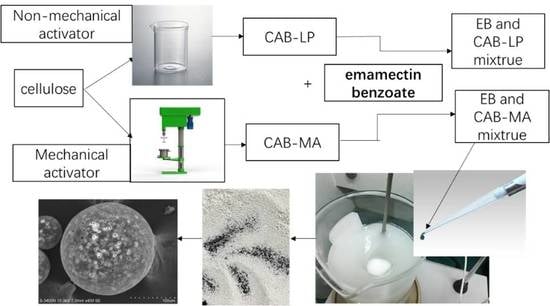Solid-Phase Synthesis of Cellulose Acetate Butyrate as Microsphere Wall Materials for Sustained Release of Emamectin Benzoate
Abstract
:1. Introduction
2. Materials and Methods
2.1. Materials
2.2. Preparation of CAB-MA and CAB-LP
2.3. Characterizations of CAB
2.4. Preparation of EB/CAB Microspheres
2.5. Characterizations of EB/CAB Microspheres
2.6. Characterizations of the Drug Loading of EB/CAB Microspheres
2.7. Release Studies of EB from EB/CAB Microspheres
2.8. Experiments for EB Photodegradation
3. Results and Discussion
3.1. Distribution of Substituted Groups in CABs with Different Synthesis Methods
3.2. Effect of Synthesis Method on Crystal Structure of CAB
3.3. Effect of Synthesis Method on Molecular Structure of CAB
3.4. Morphology of EB/CAB Microspheres
3.5. Effect of Synthesis Method on Entrapment Performance of CAB
3.6. EB Release from Microspheres and the Anti-Photodegradation Effect
4. Conclusions
Author Contributions
Funding
Conflicts of Interest
References
- Fanigliulo, A.; Sacchetti, M. Emamectin benzoate: New insecticide against helicoverpa armigera. Commun. Agric. Appl. Biol. Sci. 2008, 73, 651–653. [Google Scholar] [PubMed]
- Mushtaq, M.; Chukwudebe, A.C.; Wrzesinski, C.; Allen, L.R.; Luffer-Atlas, D.; Arison, B.H. Photodegradation of emamectin benzoate in aqueous solutions. J. Agric. Food Chem. 1998, 46, 1181–1191. [Google Scholar] [CrossRef]
- Singh, B.; Lal, H.; Pal, L.; Sharma, V. In vitro release profile of anti-ulcer drug rabeprazole from biocompatible psyllium-PVA hydrogels. J. Mater. Sci. Mater. Med. 2012, 23, 1021–1032. [Google Scholar] [CrossRef]
- Nanaki, S.; Tseklima, M.; Christodoulou, E.; Triantafyllidis, K.; Kostoglou, M.; Bikiaris, D.N. Thiolated chitosan masked polymeric microspheres with incorporated mesocellular silica foam (MCF) for intranasal delivery of paliperidone. Polymers 2017, 9, 617. [Google Scholar] [CrossRef]
- Sokolsky-Papkov, M.; Agashi, K.; Olaye, A.; Shakesheff, K.; Domb, A.J. Polymer carriers for drug delivery in tissue engineering. Adv. Drug Deliv. Rev. 2007, 59, 187–206. [Google Scholar] [CrossRef] [PubMed]
- Qi, L.; Ji, G.; Luo, Z.; Xiao, Z.; Yang, Q. Characterization and drug delivery properties of OSA starch-based nanoparticles prepared in [C3OHmim] Ac-in-oil microemulsions system. ACS Sustain. Chem. Eng. 2017, 5, 9517–9526. [Google Scholar] [CrossRef]
- Jonoobi, M.; Oladi, R.; Davoudpour, Y.; Oksman, K.; Dufresne, A.; Hamzeh, Y.; Davoodi, R. Different preparation methods and properties of nanostructured cellulose from various natural resources and residues: A review. Cellulose 2015, 22, 935–969. [Google Scholar] [CrossRef]
- Arca, H.C.; Mosquera-Giraldo, L.I.; Bi, V.; Xu, D.; Taylor, L.S.; Edgar, K.J. Pharmaceutical applications of cellulose ethers and cellulose ether esters. Biomacromolecules 2018, 19, 2351–2376. [Google Scholar] [CrossRef]
- Dewangan, A.K.; Perumal, Y.; Pavurala, N.; Chopra, K.; Mazumder, S. Preparation, characterization and anti-inflammatory effects of curcumin loaded carboxymethyl cellulose acetate butyrate nanoparticles on adjuvant induced arthritis in rats. J. Drug Deliv. Sci. Technol. 2017, 41, 269–279. [Google Scholar] [CrossRef]
- Porcu, E.P.; Salis, A.; Rassu, G.; Maestri, M.; Galafassi, J.; Bruni, G.; Giunchedi, P.; Gavini, E. Engineered polymeric microspheres obtained by multi-step method as potential systems for transarterial embolization and intraoperative imaging of HCC: Preliminary evaluation. Eur. J. Pharm. Biopharm. 2017, 117, 160–167. [Google Scholar] [CrossRef]
- Mahmood Raouf, R.; Abdul Wahab, Z.; Azowa Ibrahim, N.; Abidin Talib, Z.; Chieng, B.W. Transparent blend of poly(methylmethacrylate)/cellulose acetate butyrate for the protection from ultraviolet. Polymers 2016, 8, 128. [Google Scholar] [CrossRef]
- Fundueanu, G.; Constantin, M.; Esposito, E.; Cortesi, R.; Nastruzzi, C.; Menegatti, E. Cellulose acetate butyrate microcapsules containing dextran ion-exchange resins as self-propelled drug release system. Biomaterials 2005, 26, 4337–4347. [Google Scholar] [CrossRef] [PubMed]
- Gan, T.; Zhang, Y.; Chen, Y.; Hu, H.; Yang, M.; Huang, Z.; Chen, D.; Huang, A. Reactivity of main components and substituent distribution in esterified sugarcane bagasse prepared by effective solid phase reaction. Carbohyd. Polym. 2018, 181, 633–641. [Google Scholar] [CrossRef] [PubMed]
- Hu, H.; Liu, W.; Shi, J.; Huang, Z.; Zhang, Y.; Huang, A.; Yang, M.; Qin, X.; Shen, F. Structure and functional properties of octenyl succinic anhydride modified starch prepared by a non-conventional technology. Starch-Stärke 2016, 68, 151–159. [Google Scholar] [CrossRef]
- Zhao, X.; Huang, Z.; Zhang, Y.; Yang, M.; Chen, D.; Huang, K.; Hu, H.; Huang, A.; Feng, Z. Efficient solid-phase synthesis of acetylated lignin and a comparison of the properties of different modified lignins. J. Appl. Polym. Sci. 2017, 134, 4276. [Google Scholar] [CrossRef]
- Zhao, X.; Zhang, Y.; Hu, H.; Huang, Z.; Yang, M.; Chen, D.; Huang, K.; Huang, A.; Qin, X.; Feng, Z. Effect of mechanical activation on structure changes and reactivity in further chemical modification of lignin. Int. J. Biol. Macromol. 2016, 91, 1081–1089. [Google Scholar] [CrossRef] [PubMed]
- Zhao, X.; Zhang, Y.; Yang, M.; Huang, Z.; Hu, H.; Huang, A.; Feng, Z. Acylation of lignin with different acylating agents by mechanical activation-assisted solid phase synthesis: Preparation and properties. Polymers 2018, 10, 907. [Google Scholar] [CrossRef]
- Zhang, Y.; Wei, L.; Hu, H.; Zhao, Z.; Huang, Z.; Huang, A.; Shen, F.; Liang, J.; Qin, Y. Tribological properties of nano cellulose fatty acid esters as ecofriendly and effective lubricant additives. Cellulose 2018, 25, 3091–3103. [Google Scholar] [CrossRef]
- Tezuka, Y.; Tsuchiya, Y. Determination of substituent distribution in cellulose acetate by means of a 13C NMR study on its propanoated derivative. Carbohyd. Res. 1995, 273, 83–91. [Google Scholar] [CrossRef]
- Babu, V.R.; Rao, K.K.; Lee, Y.I. Preparation and characterization of nifedipine-loaded cellulose acetate butyrate based microspheres and their controlled release behavior. Polym. Bull. 2010, 65, 157–167. [Google Scholar] [CrossRef]
- Hornig, S.; Heinze, T. Efficient approach to design stable water-dispersible nanoparticles of hydrophobic cellulose esters. Biomacromolecules 2008, 9, 1487–1492. [Google Scholar] [CrossRef]
- Bert, V.; Wagenknecht, W. Substitution patterns of cellulose ethers influence of the synthetic pathway. Macromol. Symp. 2008, 262, 97–118. [Google Scholar] [CrossRef]
- Ispas-Szabo, P.; Ravenelle, F.; Hassan, I.; Preda, M.; Mateescu, M.A. Structure-properties relationship in cross-linked high-amylose starch for use in controlled drug release. Carbohyd. Res. 1999, 323, 163–175. [Google Scholar] [CrossRef]
- Lopes, D.G.; Becker, K.; Stehr, M.; Lochmann, D.; Haack, D.; Zimmer, A.; Salar-Behzadi, S. Role of lipid blooming and crystallite size in the performance of highly soluble drug-loaded microcapsules. J. Pharm. Sci. 2015, 104, 4257–4265. [Google Scholar] [CrossRef] [PubMed]
- Yadav, S.K.; Khilar, K.C.; Suresh, A.K. Release rates from semi-crystalline polymer microcapsules formed by interfacial polycondensation. J. Membrane Sci. 1997, 125, 213–218. [Google Scholar] [CrossRef]
- Wang, L.; Han, G.; Zhang, Y. Comparative study of composition, structure and properties of Apocynum venetum fibers under different pretreatments. Carbohyd. Polym. 2007, 69, 391–397. [Google Scholar] [CrossRef]
- Segal, L.G.J.M.A.; Creely, J.J.; Martin, A.E., Jr.; Conrad, C.M. An empirical method for estimating the degree of crystallinity of native cellulose using the X-ray diffractometer. Text. Res. J. 1959, 29, 786–794. [Google Scholar] [CrossRef]
- Lorenzo, G.; Zaritzky, N.; Califano, A. Modeling rheological properties of low-in-fat o/w emulsions stabilized with xanthan/guar mixtures. Food Res. Int. 2008, 41, 487–494. [Google Scholar] [CrossRef]
- Elanthikkal, S.; Gopalakrishnapanicker, U.; Varghese, S.; Guthrie, J.T. Cellulose microfibres produced from banana plant wastes: Isolation and characterization. Carbohyd. Polym. 2010, 80, 852–859. [Google Scholar] [CrossRef]
- Edgar, K.J. Cellulose esters in drug delivery. Cellulose 2007, 14, 49–64. [Google Scholar] [CrossRef]
- Uhrich, K.E.; Cannizzaro, S.M.; Langer, R.S.; Shakesheff, K.M. Polymeric systems for controlled drug release. Chem. Rev. 1999, 99, 3181–3198. [Google Scholar] [CrossRef] [PubMed]
- Katona, J.M.; Sovilj, V.J.; Petrović, L.B. Microencapsulation of oil by polymer mixture-ionic surfactant interaction induced coacervation. Carbohyd. Polym. 2010, 79, 563–570. [Google Scholar] [CrossRef]
- Petrovic, L.B.; Sovilj, V.J.; Katona, J.M.; Milanovic, J.L. Influence of polymer-surfactant interactions on o/w emulsion properties and microcapsule formation. J. Colloid Interface Sci. 2010, 342, 333–339. [Google Scholar] [CrossRef] [PubMed]
- Wu, Y.; Lin, X.; Wu, Z.; Möhwald, H.; He, Q. Self-propelled polymer multilayer Janus capsules for effective drug delivery and light-triggered release. ACS Appl. Mater. Inter. 2014, 6, 10476–10481. [Google Scholar] [CrossRef] [PubMed]
- Phadke, K.V.; Manjeshwar, L.S.; Aminabhavi, T.M.; Sathisha, M.P. Cellulose acetate butyrate bilayer coated microspheres for controlled release of ciprofloxacin. Polym. Bull. 2018, 75, 1329–1348. [Google Scholar] [CrossRef]
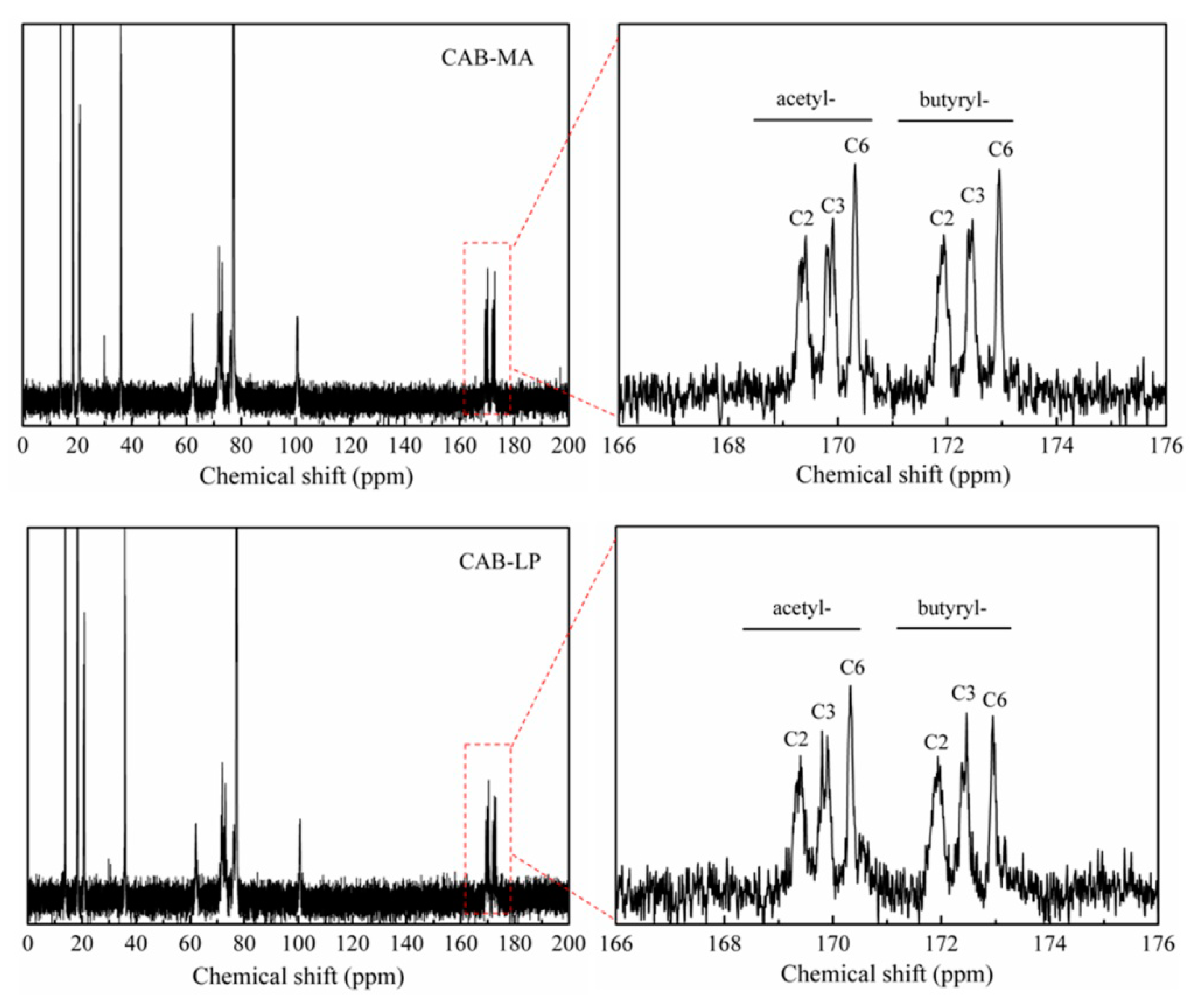
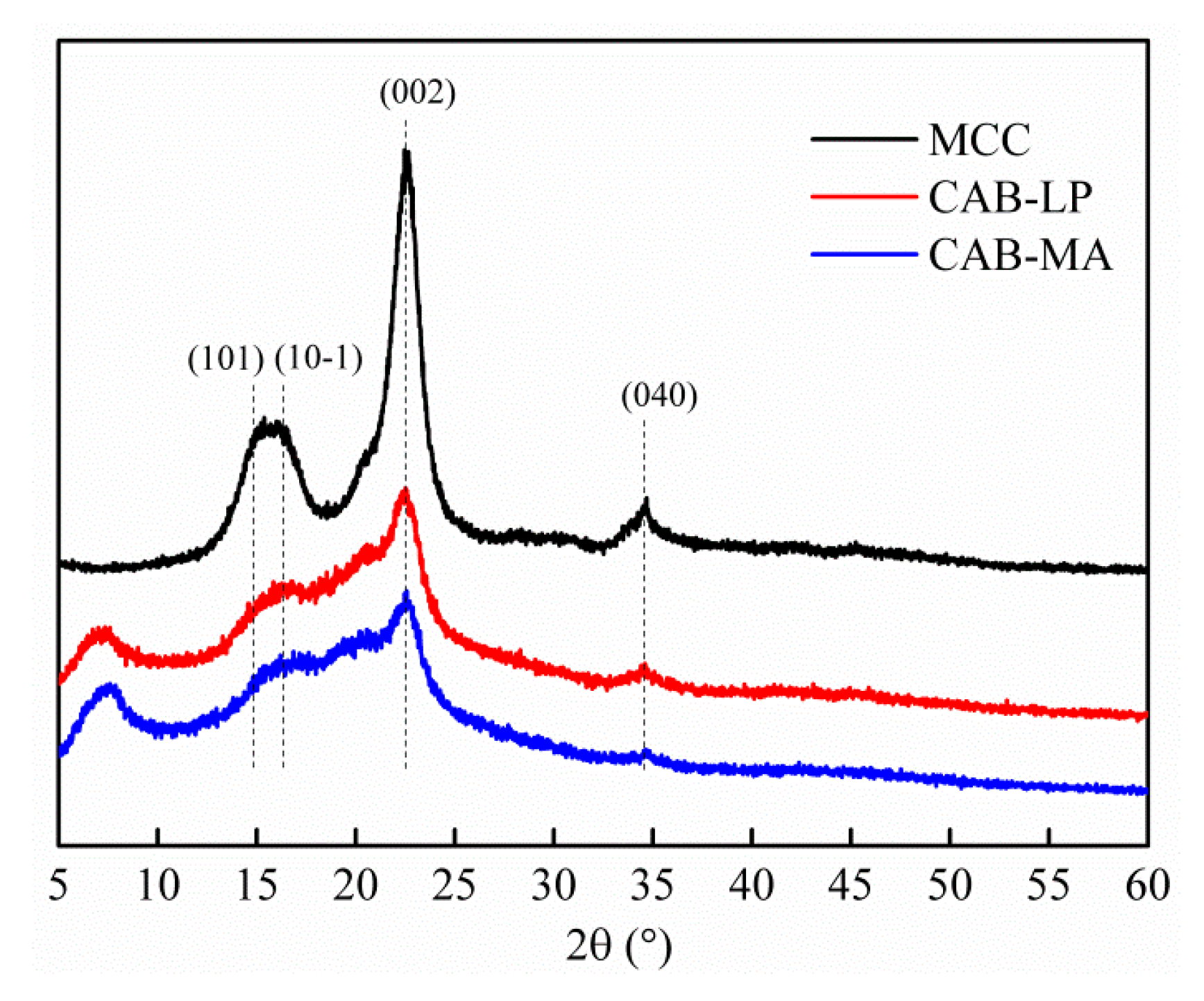
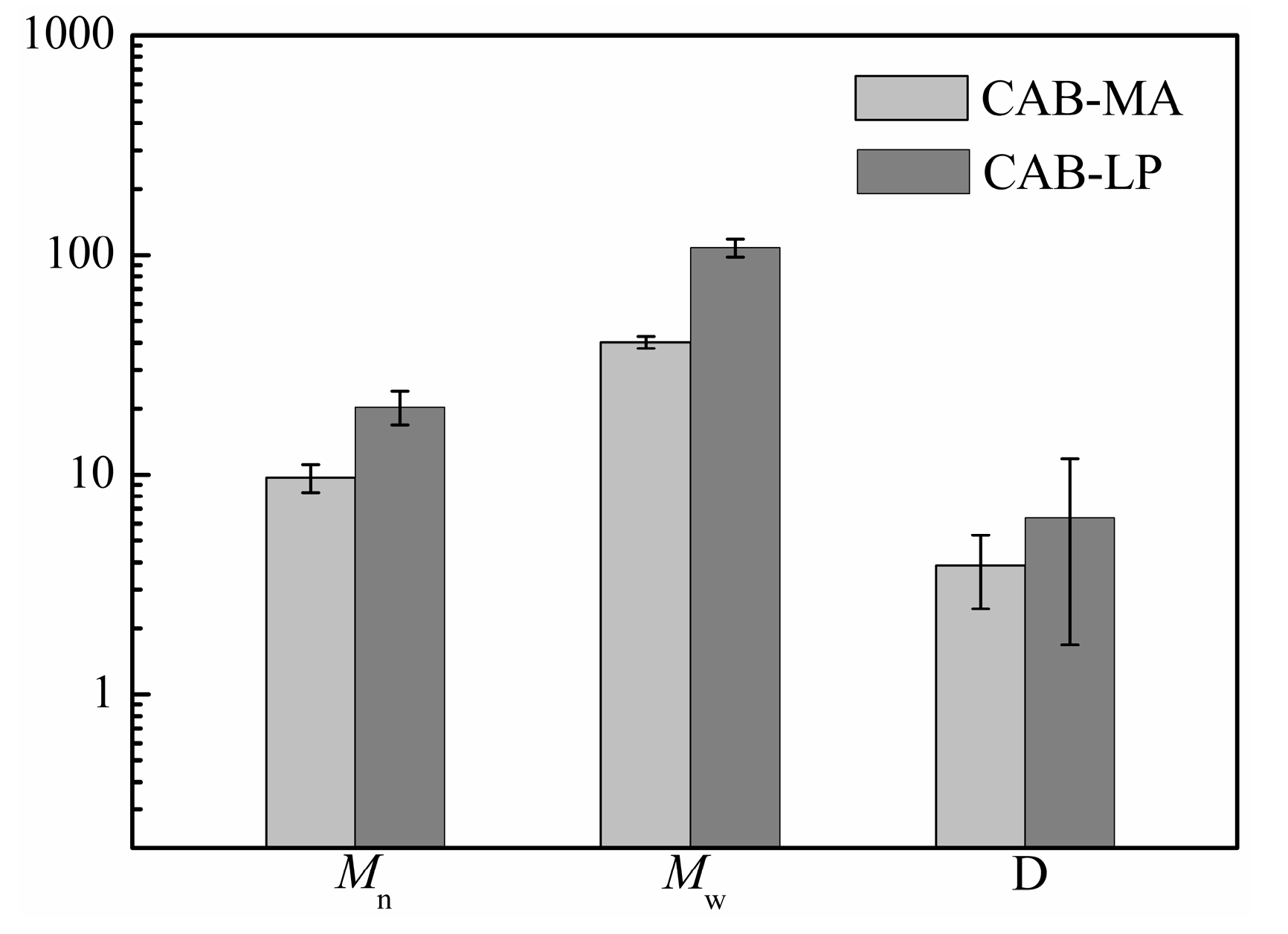
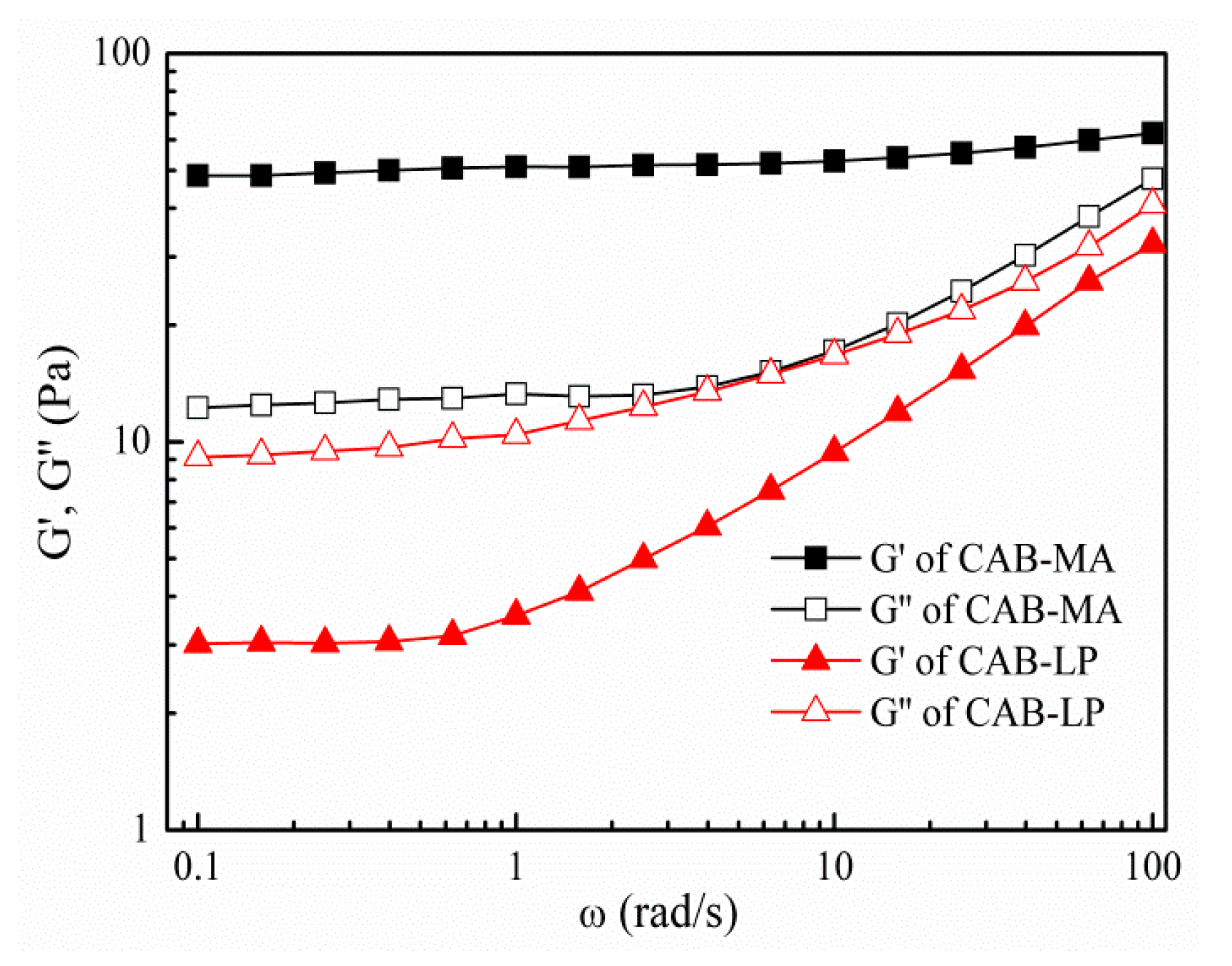
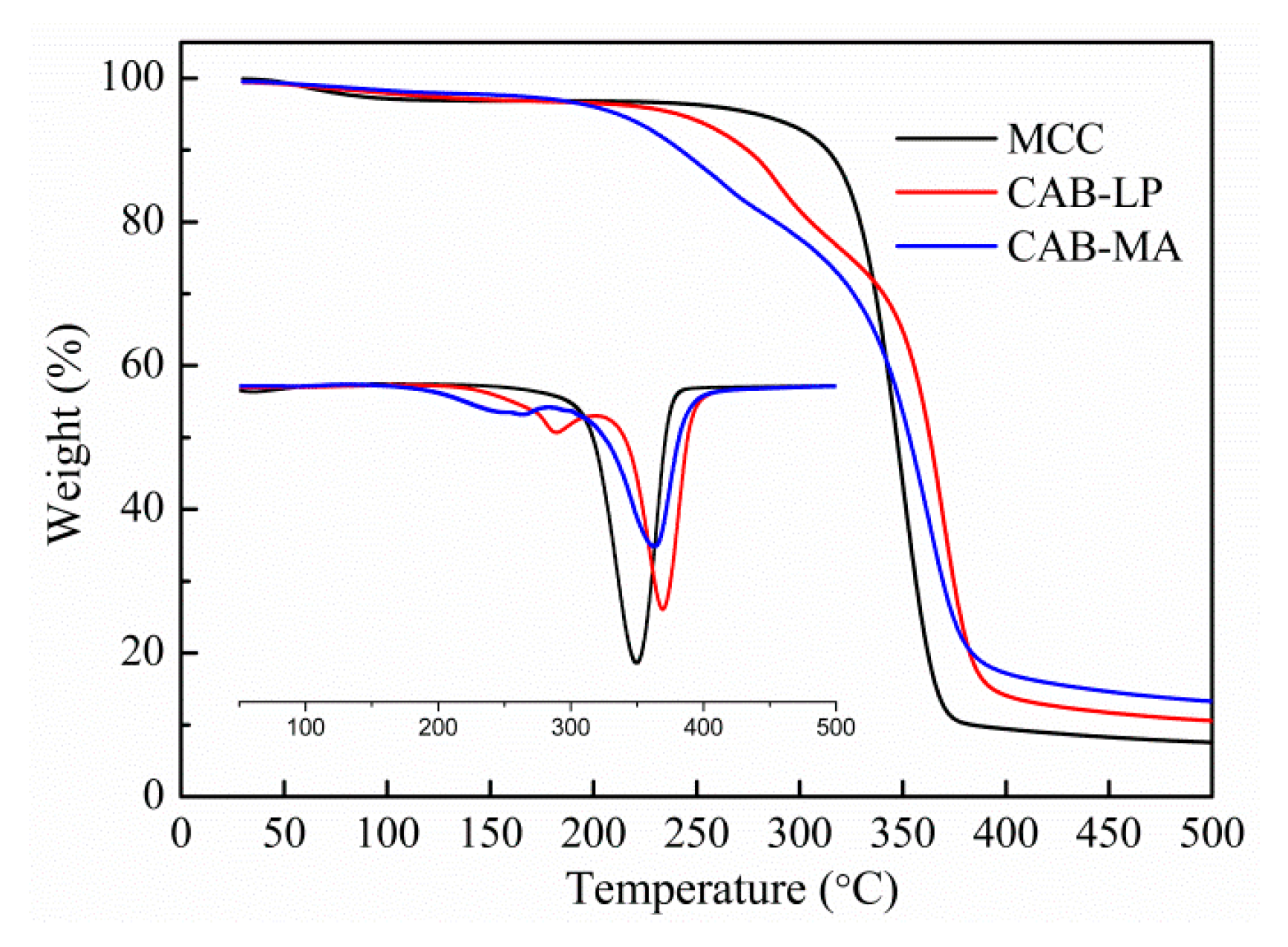
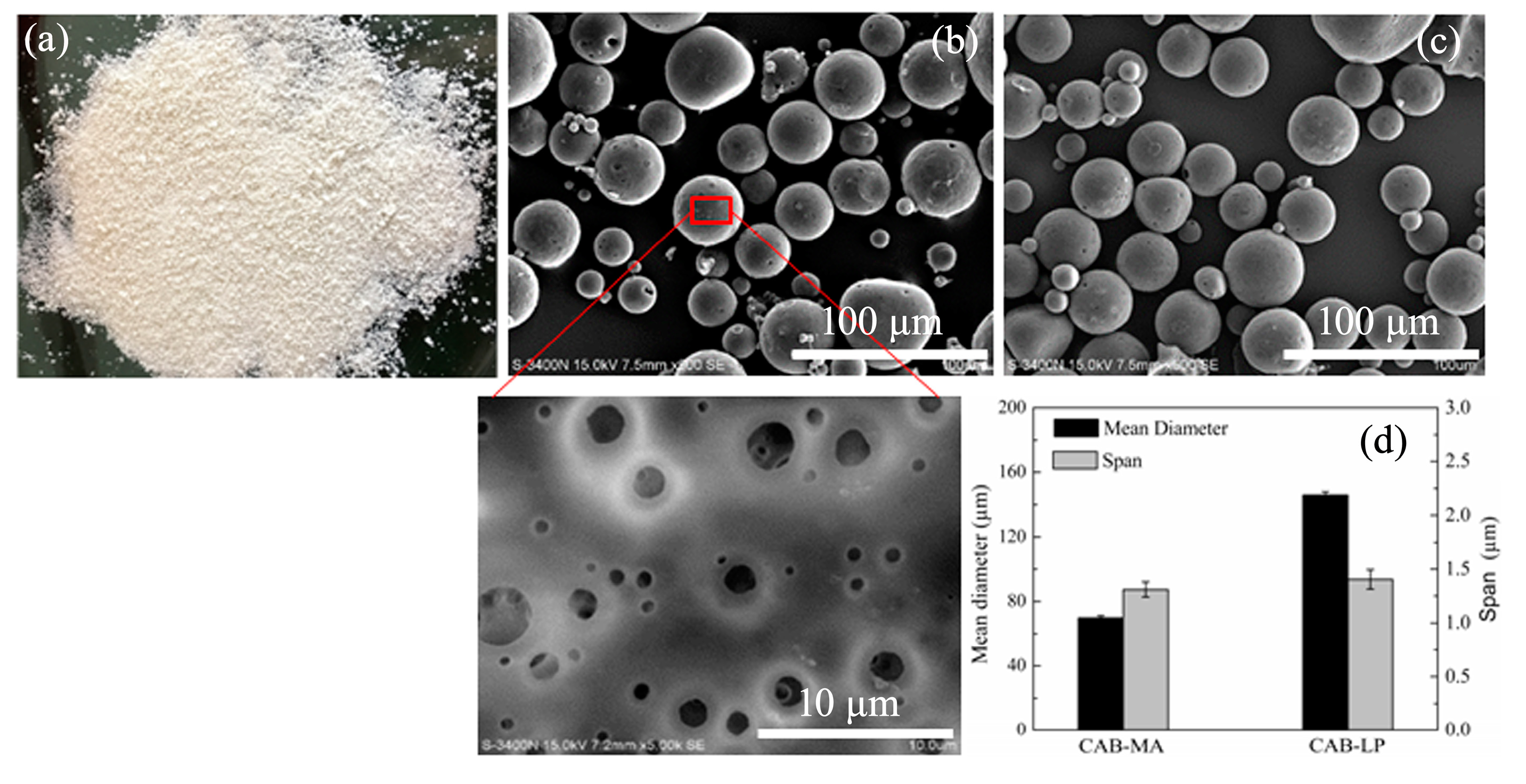
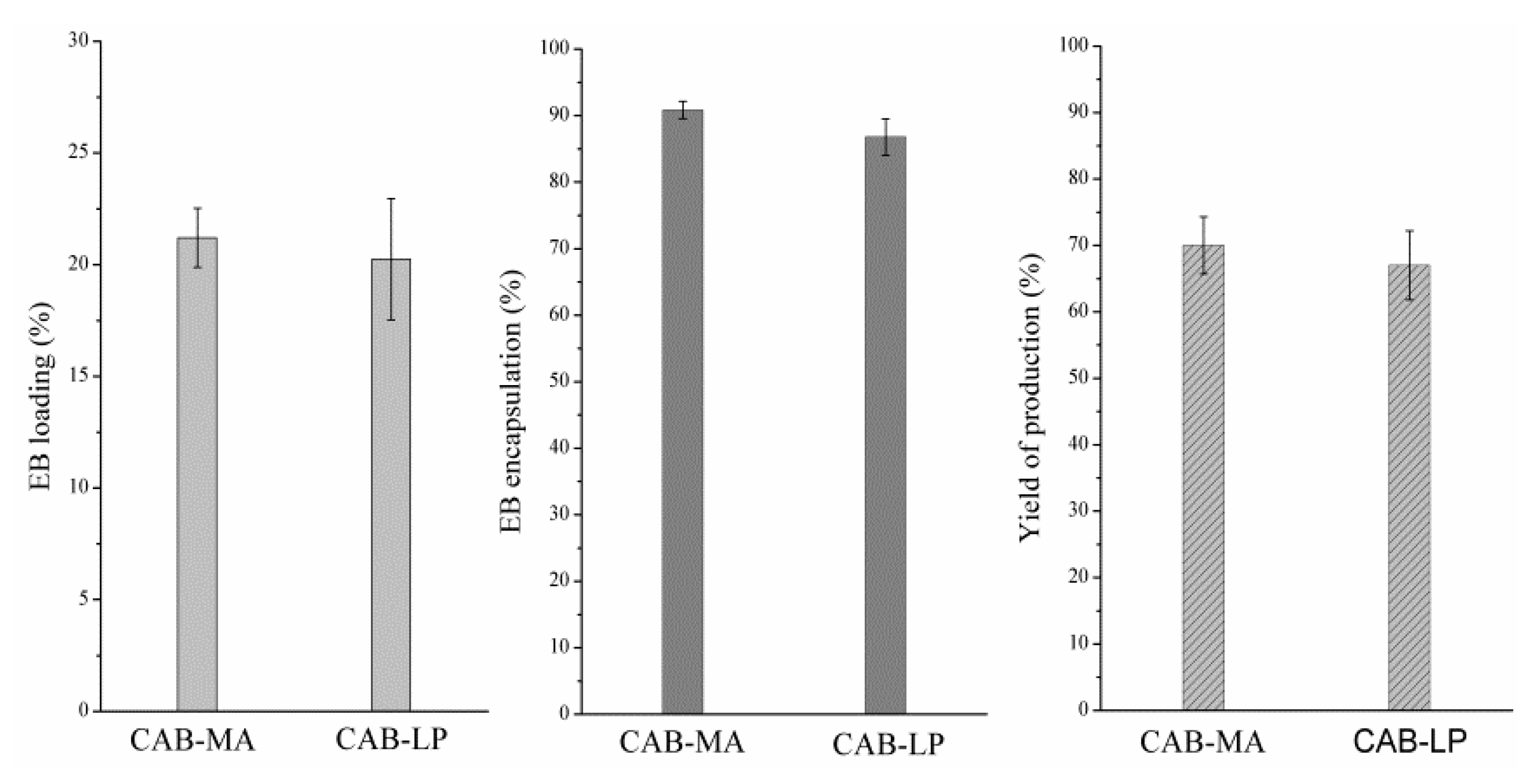
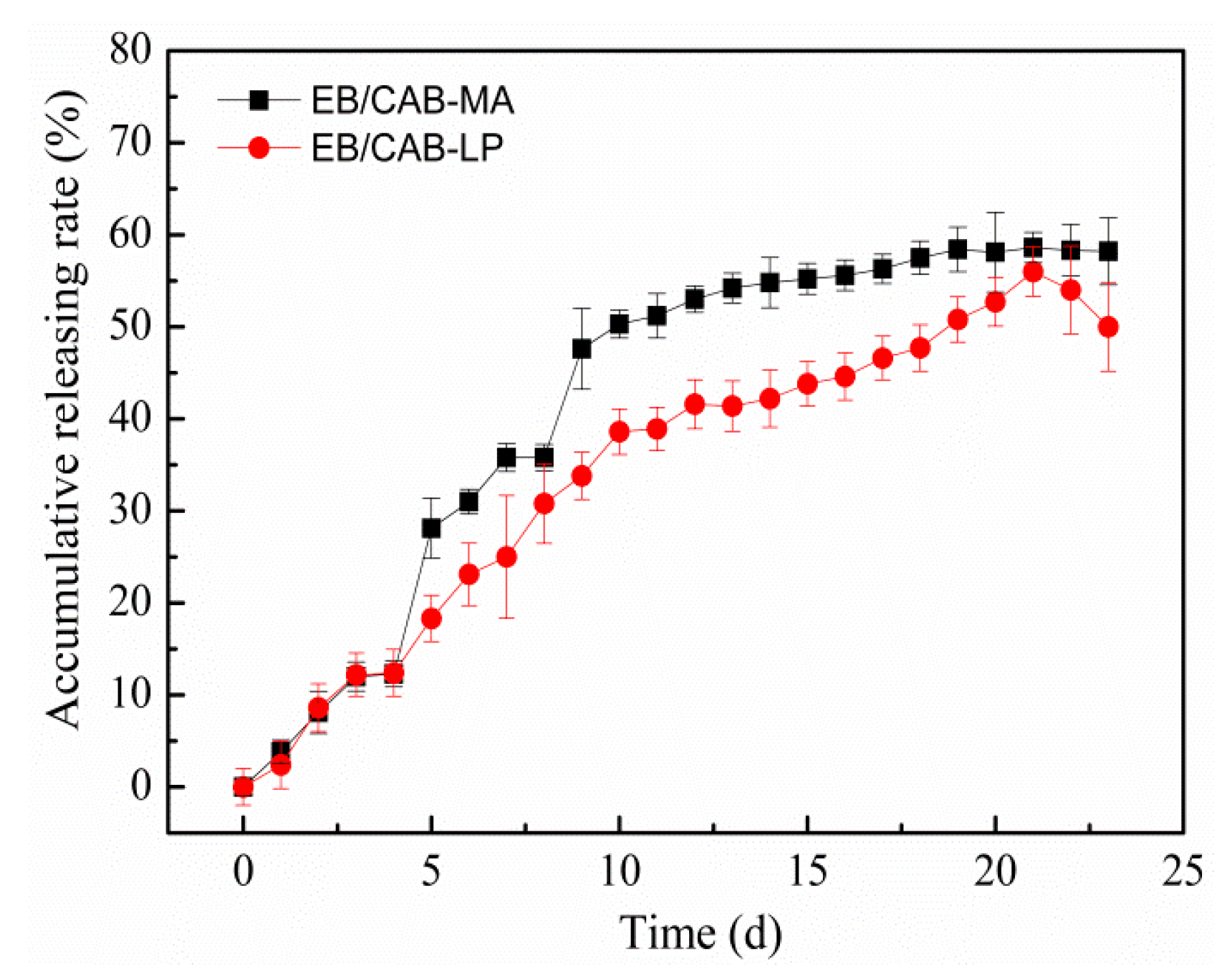
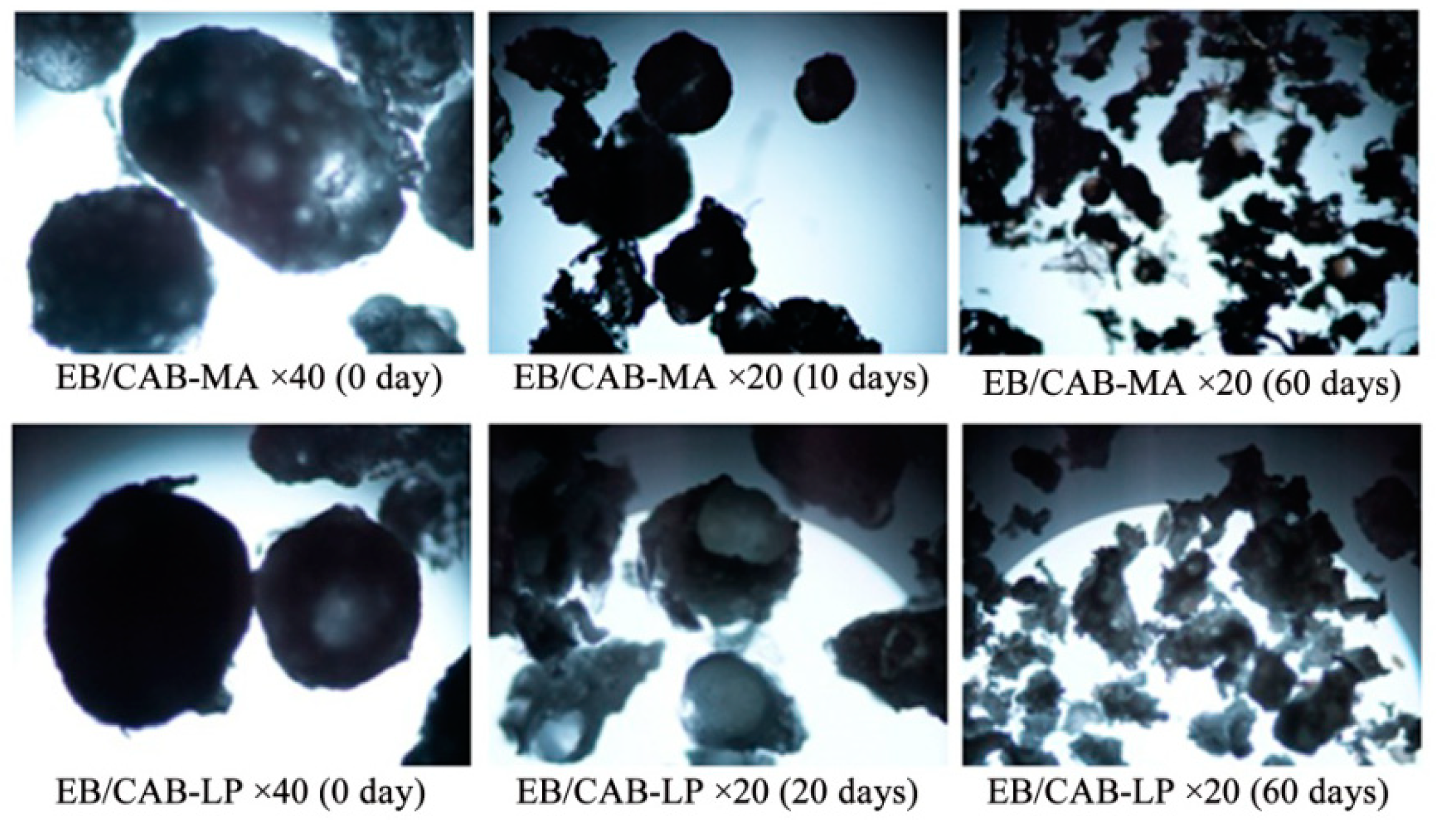
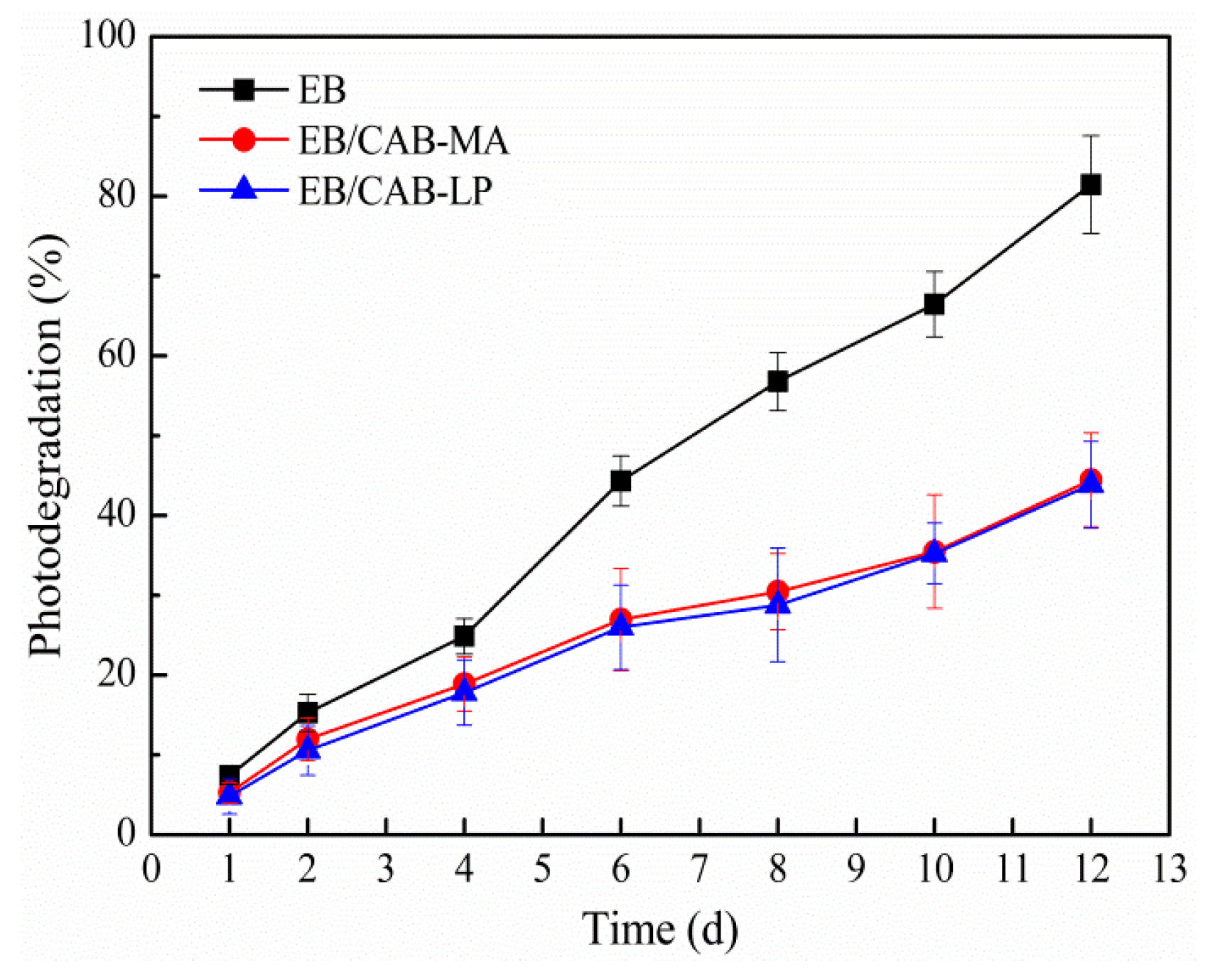
| DS of Butyryl | DS of Acetyl | DStotal | |||||||
|---|---|---|---|---|---|---|---|---|---|
| C6 | C3 | C2 | DSb | C6 | C3 | C2 | DSa | ||
| CAB-LP | 0.57 | 0.59 | 0.44 | 1.62 | 0.37 | 0.29 | 0.24 | 0.91 | 2.53 |
| CAB-MA | 0.69 | 0.52 | 0.47 | 1.67 | 0.43 | 0.33 | 0.29 | 1.05 | 2.73 |
| MCC | CAB-LP | CAB-MA | |
|---|---|---|---|
| CrI (%) | 94.9 ± 1.9 | 44.7 ± 2.8 | 21.7 ± 5.2 |
| D002 (nm) | 3.5 ± 0.4 | 3.7 ± 0.1 | 4.2 ± 0.4 |
| Zero Order | First Order | Higuchi Equation | |
|---|---|---|---|
| EB/CAB-MA | 0.8181 | 0.9590 | 0.9132 |
| EB/CAB-LP | 0.9219 | 0.9837 | 0.9633 |
© 2018 by the authors. Licensee MDPI, Basel, Switzerland. This article is an open access article distributed under the terms and conditions of the Creative Commons Attribution (CC BY) license (http://creativecommons.org/licenses/by/4.0/).
Share and Cite
Huang, A.; Li, X.; Liang, X.; Zhang, Y.; Hu, H.; Yin, Y.; Huang, Z. Solid-Phase Synthesis of Cellulose Acetate Butyrate as Microsphere Wall Materials for Sustained Release of Emamectin Benzoate. Polymers 2018, 10, 1381. https://doi.org/10.3390/polym10121381
Huang A, Li X, Liang X, Zhang Y, Hu H, Yin Y, Huang Z. Solid-Phase Synthesis of Cellulose Acetate Butyrate as Microsphere Wall Materials for Sustained Release of Emamectin Benzoate. Polymers. 2018; 10(12):1381. https://doi.org/10.3390/polym10121381
Chicago/Turabian StyleHuang, Aimin, Xuanhai Li, Xingtang Liang, Yanjuan Zhang, Huayu Hu, Yanzhen Yin, and Zuqiang Huang. 2018. "Solid-Phase Synthesis of Cellulose Acetate Butyrate as Microsphere Wall Materials for Sustained Release of Emamectin Benzoate" Polymers 10, no. 12: 1381. https://doi.org/10.3390/polym10121381
APA StyleHuang, A., Li, X., Liang, X., Zhang, Y., Hu, H., Yin, Y., & Huang, Z. (2018). Solid-Phase Synthesis of Cellulose Acetate Butyrate as Microsphere Wall Materials for Sustained Release of Emamectin Benzoate. Polymers, 10(12), 1381. https://doi.org/10.3390/polym10121381




